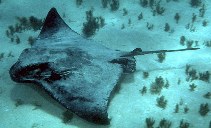| Family: |
Myliobatidae (Eagle and manta rays) |
| Max. size: |
150 cm WD (male/unsexed) |
| Environment: |
benthopelagic; brackish; marine; depth range 0 - 160 m |
| Distribution: |
Southwest Pacific: Norfolk Island and New Zealand, including the Kermadec Islands. |
| Diagnosis: |
Olive-green, yellow or dark brown dorsally with pale blue or grey markings; white ventrally (Ref. 26346). No caudal fin (Ref. 26346). |
| Biology: |
Occurs in bays, estuaries, and near rocky reefs (Ref. 12951). Usually solitary (Ref. 12951). Feeds on clams, oysters, worms, and crabs (Ref. 12951). Ovoviviparous (Ref. 50449). Although the spine on the tail is capable of inflicting a painful wound, the poison is quickly neutralized by immersion of the injured area in hot water (Ref. 26346). |
| IUCN Red List Status: |
Least Concern (LC); Date assessed: 06 October 2015 Ref. (130435)
|
| Threat to humans: |
venomous |
Source and more info: www.fishbase.org. For personal, classroom, and other internal use only. Not for publication.
